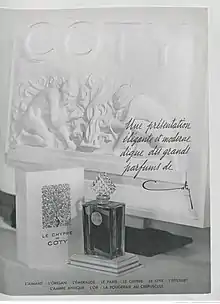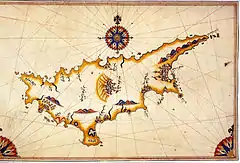Chypre
Chypre (pronounced [ʃipʁ] or [ʃipχ]) is the name of a family (or concept) of perfumes that are characterised by an accord composed of citrus top notes, a middle centered on cistus labdanum, and a mossy-animalic set of basenotes derived from oakmoss. Chypre perfumes fall into numerous classes according to their modifier notes, which include but are not limited to leather, florals, fruits, and amber.[1]
History

The term chypre is French for the island of Cyprus. Its connection to perfumery originated with the first composition to feature the bergamot-labdanum-oakmoss accord, François Coty's perfume Chypre from 1917 (now preserved at the Osmothèque), whose name was inspired by the fact that its raw materials came predominantly from Mediterranean countries.[2] Although perfumes in a similar style had been created in the 19th century, Coty's 1917 composition was so influential that it inspired many descendants. It ultimately became the progenitor of a whole family of related fragrances sharing the same basic accord, which came to be known as "chypres."[3]
Chypre in popular culture
- Marya – the protagonist of Jean Rhys's semi-autobiographic debut novel, Quartet (Chatto and Windus, 1928) – asks a young woman in the Paris demimonde she frequents whether she wears the Coty fragrance Chypre.
- In Aldous Huxley's Brave New World (1932), the main female character, Lenina Crowne, “dabbed herself with chypre” after drying off from a bath.
- Raymond Chandler's The Lady in the Lake (Knopf, 1943) also mentions a chypre-scented, monogrammed handkerchief.
- In Lawrence Durrell's Alexandria Quartet (Mountolive, first published in 1958), the protagonist, British diplomat David Mountolive, recognizes the "nervous handwriting" of his one-time lover, Leila Hosnani, on an envelope smelling of chypre.
- In the novel The Maltese Falcon, the character Joel Cairo (a dainty but ineffective thug) wears the chypre scent.
- In the movie version, "chypre" scent is replaced with "gardenia" scent.
- One of the two physical editions of Le Sserafim's Fearless is given the subtitle "Blue Chypre".
Style, concept
The chypre concept is characterised by the contrast between the fresh citrus accord and the woody-oakmoss base; often patchouli is considered an indispensable element as well.[4] The chypre accord is used in both male and female perfumery.
Modern chypre perfumes have various connotations. There can be floral, fruity, green, woody-aromatic, leathery, and animalic notes, but the chypre concept is to be easily recognized by the "warm" and "mossy-woody" base which contrasts the fresh citrus top, and a certain bitterness in the drydown from the oakmoss and patchouli. The chypre accord consists of:
- Citrus: singular or blends of bergamot, orange, lemon or neroli
- Cistus labdanum: warm and resinous
- Oakmoss: mossy and woody
- Patchouli: camphoraceous and woody
- Musk: sweet, powdery, and animalic. Usually synthetic in modern times.
The composition is usually enhanced with a floral component through rose and jasmine oil.
Animalic notes such as civet can be added to this accord to provide richness, but are less popular in modern perfumery. The most common modifiers to this basic accord include patchouli, bergamot, vetiver, ambergris, sandalwood and labdanum resin.[5]
Subfamilies
The chypre fragrances generally fit into the Oriental and Woody family of fragrance wheel classification. They can also be classified into several styles:
- Leather and/or animalic chypres, such as Bandit by Robert Piguet (1944), Cabochard by Grès (1959), and Azurée by Estée Lauder (1969).
- Floral chypres, such as Calèche by Hermès (1961), Krasnaya Moskva by Novaya Zara (1925), and Knowing by Estée Lauder (1988).
- Fruity chypres, such as Femme by Rochas (1944), Mitsouko by Guerlain (1917), and Diorama, by Dior (1949).
- Green chypres, such as Givenchy III by Givenchy (1970), Ma Griffe by Carven (1946), and Aliage by Estée Lauder (1972).
- Woody chypres, such as Aromatics Elixir by Clinique (1972).
- Fresh chypres, such as CK One by Calvin Klein (1994).
Notable examples of chypre-type perfumes
Chypre by Coty was so well known its name still can be confused with other chypre perfumes labelled "chypre."
- Krasnaya Moskva is a feminine chypre perfume made in the USSR in 1925, known for its strong, excessive sillage.
- One of the most popular chypre perfumes was the original Miss Dior, a floral chypre launched by Christian Dior in 1947. However, the formula was later changed, likely due to issues with the ingredient oakmoss.
- Since the mid-1980s, Karl Lagerfeld cologne, orange in color, called "Lagerfeld" is a modern chypre scent for both men and women.
- Oakmoss powder was used as a scent in the 16th century, known as poudre de chypre.[6]
- Eau de Chypre was a fragrance by Guerlain in 1840.[6]
- The A. Siu and Co. soap factory, based in Moscow, offered a "parfums a la mode" soap package that included "шипръ" soap, as seen at position №677 on this bulk price list from 1904.
- Shipr cologne (Cyrillic spelling: "ШИПР," a transliteration of the French "chypre," is a masculine chypre cologne released by Brocard and Co. (later known as Novaya Zarya) in 1889.[7] Its key notes include the chypre accord and vanilla. This cologne is mentioned in the 1909 poem "Отъезд Петербуржца" by Sasha Chorny.
References
- "Chypre" Microsoft Encarta Dictionary, 2006
- Turin, Luca, and Tania Sanchez. The Little Book of Perfumes: The 100 Classics. London: Profile, 2011. Print.
- Musées de Grasse Archived 2007-08-10 at the Wayback Machine, the International Perfume Museum
- H&R Fragrance Guide/Duftatlas/Atlas Olfactif, Quensen & Oudras Verlag, Lamspringe, 2000, p. 14, ISBN 3-922805-69-8
- Definition of the chypre family from Musées de Grasse Archived 2007-03-10 at the Wayback Machine
- link to the book on Google Books, chapter 18.3.3. Chypre Accord
- "Shipr Nouvelle Etoile – Новая Заря cologne - a fragrance for men 1889". www.fragrantica.com. Retrieved 20 June 2021.
